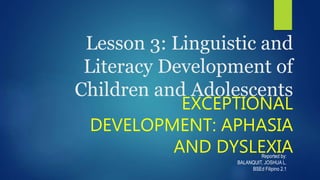
Aphasia and Dyslexia
- 1. Lesson 3: Linguistic and Literacy Development of Children and Adolescents EXCEPTIONAL DEVELOPMENT: APHASIA AND DYSLEXIAReported by: BALANQUIT, JOSHUA L. BSEd Filipino 2.1
- 2. Language disorder refers to any systematic deviation in the way people speak, listen, read, write or sign that interferes with their ability to communicate with their peers. It covers a wide spectrum dysfunction as in fluency and articulation disorders. This affects the structure, content and even the use of language . There are many causes but a large proportion of cases are traced from brain damage
- 3. APHASIA The language impairment that is caused by specific brain damage It is the loss of ability to use and understand language. It excludes other language disorders caused by physical conditions such as deafness. It can be categorized according to the particular area of the brain damaged into receptive, expressive and global aphasias. Types of Aphasia Broca’s Wernicke’s Anomic Global
- 4. BROCA’S APHASIA (Expressive or Motor Aphasia) - damage to Broca’s area - trouble with speech production - reading and writing as effected (can be in some through) - deaf people can be sometimes have difficulty signing if Broca’s effected. BROCA’s APHASIA - Spontaneous speech is non fluent a. Speech becomes slow and labored. b. It may sound telegraphic, with function words like articles, conjunctions and prepositions missing but response generally make sense. - Speech articulation is slurred. - Comprehension is not seriously affected.
- 5. WERNICKE’S APHASIA (Receptive or Sensory) Damage to Wernicke’s Area results in: Loss of meaningful messages Language comprehension difficulty, especially with complex sentences. SYMPTOMS OF WERNICKE’S APHASIA They do not understand what others say Poor comprehension of spoken and written language Difficulty repeating sentences accurately. Unaware of their own language errors and disorganized speech patterns. Word finding problems are
- 6. ANOMIC APHASIA (Isolation Syndrome) It is fluent and expressive with relatively few deficits in language expression or comprehension with the exception of naming. This form of aphasia is the most pervasive type of chronic condition even after treatment and is the most common of aphasia profiles. SPEECH: Naming Deficit Fluent Normal Comprehension Able to repeat DYSNOMIA: Mild difficulty in naming
- 7. GLOBAL APHASIA (Central or Irreversible) Severe form of non fluent aphasia caused by damage to the left side of the brain that affects receptive and expressive language skills (needed for both oral and written language) as well as auditory and visual comprehension. Combination of Broca’s and Wernicke’s Aphasia.
- 8. PRIMARY PROGRESSIVE APHASIA (PPA) Is a neurological syndrome in which language capabilities become slowly and progressively impaired. Unlike other forms of Aphasia that results from stroke or brain injury. Is caused by neurodegenerative disease, such as Alzheimer’s Disease or Fronto Temporal Lobar Degeneration.
- 9. THREE (3) SUBTYPE OF PRIMARY PROGRESSIVE APHASIA (PPA) 1. PROGRESSIVE NON FLUENT / AGRAMMATIC APHASIA - people with this subtype having difficulty speaking- have difficulty planning how “speech muscles” will form words – but still know the meaning of words. Grammar problems are key feature of this subtype. 2. SEMANTIC VARIANT PPA - People with this subtype lose the meaning of words (comprehension). A person with this type of PPA can speak fluently but things they say might not make sense and they might have trouble understanding what others are saying.
- 10. 3. LOGOPENIC APHASIA (aka Progressive Fluent Aphasia) - People with this subtype have difficulty finding the right words when they are speaking, but they usually still know the meaning of words. SYMPTOMS OF PPA AT EARLY-STAGE: • Slowing down, pausing or stopping of speech • Word-finding difficulty • Written or spoken sentences with abnormal word order • Mispronouncing words • Difficulty writing/reading • Problems with spelling/arithmetic • Inability to remember familiar objects or how they are used • Substituting a similar letter sound – for ex: “t and d”
- 11. DYSLEXIA - It is a defective reading that represents loss of competency due to brain injury, degeneration and developmental failure to keep pace with reading instructions. DYSGNOSIA x) - Means inefficient recognitions. This term was introduced by Sigmund Freud in 1891 to means loss of the ability to recognize objects. AGNOSTIC DYSLEXIA (Agnosic Alexia) - Remains after a more generalized agnosia in adults with brain lesions. Patients can read but throw a slow, letter by letter analysis of a word. When there are errors in reading this results in distortions of words rather
- 12. POSTERIOR ALEXIA or PURE ALEXIA - Without agraphia (pure alexia) is an acquired reading disorder in which patient is unable to read, despite preservation of other aspects of language such as spelling and writing. PURE ALEXIA - Perceptual disorder causing impairment in reading words and letters. - Patient can write to dictation but is unable to read back what has been written. - The patient can copy words and letters and in the act of copying the words or tracing out the letters may recognize the word or letter.
- 13. VERBAL ALEXIA - Associated with occipital lesions where patients could easily recognize letters but could not grasp whole words. It is accompanied by a gaze disturbance in which patients easily lost their place in lines and picked out fragments from different lines. OPTIC ALEXIA - Is seen in adults with occipital lesions where letters similar in configuration are mistaken from another. For example, “M and N or K and X”.